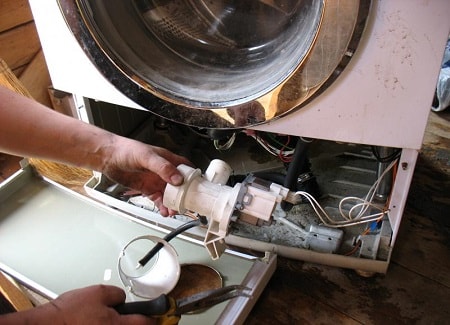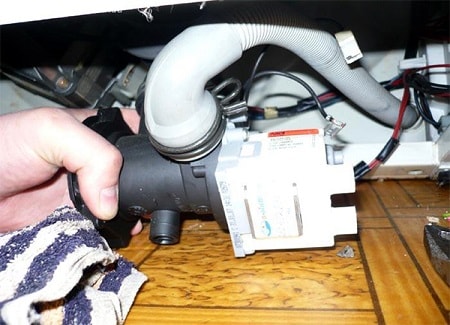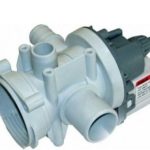The washing machine pump is an essential element to ensure the required performance and stability. The pump directly pumps in water, and also drains it after the end of the wash. If problems arise with this, then it may be necessary to repair the washing machine pump with your own hands. Usually, after several years of operation, the degree of wear makes itself felt that it needs to be checked or even replaced.
The main symptoms of a malfunctioning washing machine pump
If the washing machine malfunctions, then the first step is to diagnose. Only after establishing the exact reason, you can start repairing the pump yourself. Typical signs of a pump failure are:
- lack of response to given programs;
- strong hum when pouring or draining water;
- water is supplied in an incomplete volume;
- the machine shuts down during the filling process or somehow malfunctions.
Usually your washing machine works in automatic mode - you do not need to perform any unnecessary actions. If it doesn't, then the impeller may need to be checked or the entire pump replaced.
![]() See also - Why does the washing machine make a lot of noise during spinning
See also - Why does the washing machine make a lot of noise during spinning
Various actions should be taken to diagnose and routinely repair and troubleshoot problems:
- listen to the pump during operation for extraneous sounds;
- open the case and clean the drain filter;
- clean the drain hose;
- check if the pump impeller rotates normally, if there are no seizures.
In addition, the problem may lie in the electronics, for example, the contacts going to the pump are damaged or disconnected. Sensors can also fail to ensure stable operation.
After that, you can determine what exactly is wrong with the washing machine and how to carry out repairs. If you are sure that the whole thing is in the pump, then you can proceed directly to the repair with your own hands. This will require the usual set of tools. Correct execution of all actions will help save cars, so you don't have to replace your pump. Otherwise, the contacts or the motor itself may burn out.
Where is the washing machine pump located?
Before proceeding with the disassembly, you should establish exactly where the pump itself is located, as well as all the main parts. Despite the large size, the design of such household appliances is quite thought out, so you can carry out repairs without much effort with your own hands.
Popular models Samsung, Beko, LG, Whirpool, Ariston, Candy, etc. it is located at the bottom, so the machine itself must be carefully laid on its side. After that, it remains only to remove the cover, under which the desired part is immediately located.

The Zanussi and Electrolux machines are still simpler - the lid is located at the back, so it is enough to unfold or slightly move the equipment away from the wall. The cover is fastened with several screws.
The situation is more complicated with the Bosch, Siemens and AEG models, because in this case you will have to dismantle the front panel completely.
Washing machine pump repair procedures
From the description above, you already figured out how to check the water pump of the washing machine. After that, you can start troubleshooting, and quite often you can do it yourself. First, you should pay attention to the most common malfunctions:
- damage or blockage of the drain hose;
- clogged drain filter;
- impeller jamming due to debris or solid objects.
The filter can be cleaned by hand without much difficulty. Hair, threads, and other debris accumulate there over time, which should be removed. Sometimes this happens more often, sometimes less often, but the problem with washing machines is quite common.
Next, you should deal with the drain hose. Even if visually it is in order, it still does not fit to rinse it. To do this, you need to remove and run a stream of hot water through it.

After that, it is recommended to test the washing machine. Just run a test wash to see how well the pump is pumping and draining water. For this, the most common rinse mode or some other is suitable. If there are no extraneous sounds, and the water gets inside normally, then everything is fixed. But if the pump continues to malfunction, then turn off everything and continue to repair.
The next step is to check the drain pump impeller. The good news is that you can get to it even without serious analysis of the technique. To do this, simply unscrew the drain filter, under which the rotating blades are located.
At this moment, the following actions are performed:
- get to the drain filter and check it;
- unscrew the filter and carefully remove it from the hole;
- shine a flashlight on the hole to better inspect;
- try to twist the blades with your hands;
- remove debris if present.
Typically, the impeller on the pump should not rotate too easily, but also without obvious difficulty. If this does not happen, then most likely foreign objects have got inside. Sometimes coins, plaques, bra knuckles, and other similar items get there from clothes. Ordinary threads or hair can also make rotation difficult. Usually, all this can be removed without much difficulty with your own hands, so you do not have to engage in serious repairs and disassemble the washing machine.
Washing machine pump repair and replacement tools
If the impeller does not rotate well without foreign objects, then this indicates more serious damage to the pump. As a rule, this means damage to the mechanism, so you have to disassemble everything and carry out a more detailed inspection. Scrolling through time is a clear sign - this indicates problems with contacts or sensors. Accordingly, you will have to repair or completely replace them.
If you get down to business, then you better buy new parts in advance to repair your washing machine. The main components are:
- drain pump for a specific model of your equipment (preferably assembled);
- cuffs and gaskets;
- a new impeller for a specific model, taking into account the dimensions;
- axle and pulley for fastening;
- contacts and sensors related to the pump.
Typically, these parts can be purchased from a specialist store or service center. If there is no such place nearby, you can order everything through the official website or through the service center. Usually the masters are ready to help with this. To avoid inaccuracies, take the entire pump or a single part with you so that the consultants can select an exact copy.
See also:

